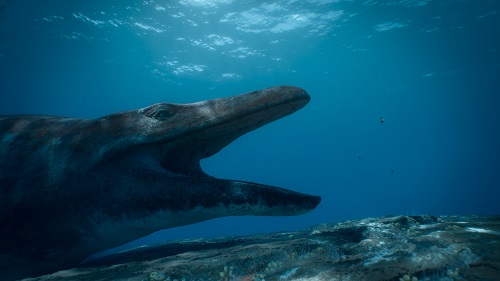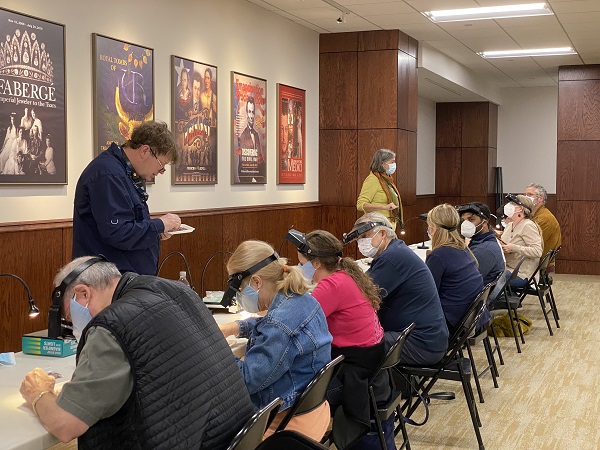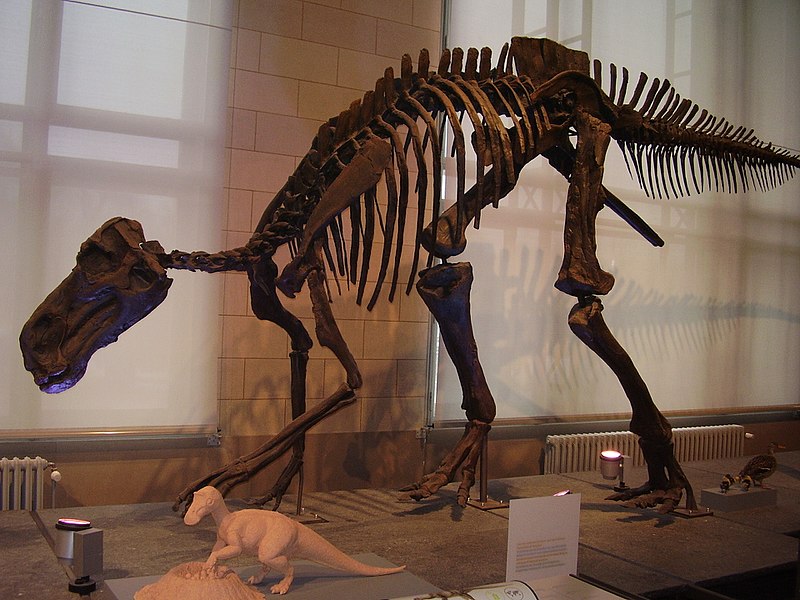Congregationalist Minister, Director of the Massachusetts Geological Survey, and First to Prove that Dinosaurs Had Feathers.
Part Two: U-boats and the Knuckle Decipherment.
(Read Part One Here)
Ferocious Flat-foots frighten second grader. A cartoon from Punch 1855 shows three dinosaurs restored at the Crystal Palace as big-shouldered and flat-footed. Supposedly kids were dragged kicking and screaming through the rows of monstrous sculptures.
Last year we left our dear friend, the Reverend Hitchcock, footprint sleuth of the 1830’3-50‘s, close to solving the riddle of the track-makers who stomped all over his Jurassic landscape. It wasn’t just a local New England puzzle. Similar tracks were excavated in Europe, Asia, Africa, Brazil — everywhere sediments were dated to the Jurassic, Late Triassic and Cretaceous. Hitch knew these beasts were bipeds, striding swiftly across muddy flats and sand bars, holding their heels high off the ground. Could they have been dinosaurians?
Absolutely, positively NOT! All the wise men of paleontology said Hitch’s tracks were totally, completely, astoundingly different from the imprints that would be made by a real-life dinosaur. All the textbooks and monographs said that dinos were flat-footed quadrupeds, and that’s the way they were restored as life-sized sculptures in the Crystal Palace Exhibition in a park just outside of London in the 1850’s. The 3-D dinos proudly displayed all the latest discoveries from the very best minds in Europe. This exhibition was the first “Jurassic Park” style extravaganza anywhere. Record crowds came and gawked at the Jurassic and Cretaceous behemoths. Three separate dino species were shown in giant models, plus assorted extinct crocs, ‘dactyls and sea-reptiles. All three dinos were shown as pentadactylus flat-footed monsters. All had forefeet as big as their hind feet and monstrously muscled shoulders. All the officially sanctioned dino-models on sale at the gift shoppe were five-fingered and five-toed too.
You could buy posters of the dinosaurian flat-foots and tiny miniatures cast in lead to act as paperweights or kids’ toys. Textbooks and encyclopedias were swayed by the exhibit and carried the same anatomical message. The Dinosauria as a group had legs like bears, with forepaws designed to excavate holes and bring down prey with one swipe of the claws. Tracks made by such beasts would, of course, display five digits fore and aft. The footprints had to leave big flat-footed sole marks too. Therefore, Hitchcock’s track-makers couldn’t be dinos, everyone knew that. Hitch’s favorite Jurassic critters had three main toes in the hind paw, arranged so the middle toe was the longest. Hind feet were gigantic, dwarfing the front paws in the few species who came down on all fours. Nothing could be more different from what science had discovered about dino paws.
Don’t be misled by the cryptic title. Here’s the best book on the Enigma Machine during World War II. Read this book to get the true story of Alan Turing and the cracking of the Nazi U-Boat code, as portrayed in the hit movie “The Imitation Game”
Triumph of the Congregationalist Mind: The digital decipherment.
There was a puzzling disconnect between what the bone-scientists said and what Hitch and his fellow track-analysts were thinking. The bone guys saw dinosaurs as the commonest big land animals of the Jurassic, and the dinos were four-legged flat-foots, so they thought. Oddly, no one could find fossil footprints that matched the dino reconstructions. There were no giant flat-footed tracks in the rocks that contained giant dino skeletons. Odd, very odd.
Hitchcock ignored dinosaurs as they were reconstructed in Europe. He focused on bringing back to life the bipeds who had left behind the spectacular tracks in New England. To realize his life’s goal he needed to “see” the foot skeletons of his track-makers. But he had no fossilized pedal petrifications. No ankle bones; no toe bones, no fingers. He needed a miracle. He needed time-traveling x-ray vision that would reveal exactly where each and every bone fit in each and every toe. Congregationalists didn’t believe in miracles, not in the normal course of scientific work. What Hitchcock believed in was the power of the analytic mind and the beautiful regularity in the design of Nature. Here all his sole-searching paid off big. He already possessed the best set of diagrams of feet from living species, thanks to all the time spent chasing critters across muddy fields. Now he needed to sit down and search for the key that would unlock the skeletal.
Hitch succeeded. He cracked the code of the tracks. This decipherment must stand as one of the most heroic triumphs in the history of de-encryption, right next to the cracking of the U-boat signals sent by World War Two’s Enigma Machine. That Enigma Code story is told in the movie “The Imitation Game” with Benedict Cumberbatch playing the math genius Alan Turing. During the early days of the war, England was being starved by the U-boat offensive.Cargo was being sunk so fast that food, ammo, and guns were running short. The key to the U-boat success was the system of commands coming from German naval headquarters, sent in a new code that was diabolically complex. Each message was encrypted by the “Enigma Machine” that scrambled and double scrambled and triple scrambled every word.
Turing and his crew were told “The Enigma Machine is impregnable — no one can figure it out.” The crew took that as a challenge. They triumphed! (Note: it was more of a team effort than shown in the movie). Soon the Brits were reading the Nazi messages before the sub commanders did. U-boats were intercepted. Depth charges were dropped with precision. Salvos of hedgehog rockets were fired (Google “hedgehog”). The undersea threat was neutralized.
 Ms. Emily Dickinson and a World War II U-boat. The U-boat is at the left. To learn more: “Dickinson, Selected Poems and Commentary” by Helen Vendler, 2010, Harvard University Press.
Ms. Emily Dickinson and a World War II U-boat. The U-boat is at the left. To learn more: “Dickinson, Selected Poems and Commentary” by Helen Vendler, 2010, Harvard University Press.
I imagine Cumberbatch or maybe Anthony Hopkins playing Hitch in the movie “Dino-Code Breaker”. I see Hitch hunched over his drawing board surrounded by pickled feet of local newts, frogs, toads and a bandicoot paw sent from Captain Cook’s explorations. Angelina Jolie, plays poet Emily Dickinson, a frequent visitor to the Hitchcockian lab. She brings him a cup of tea and a translation of a French monograph on mole feet. The candles burn down to their pewter holders. Light flickers.
“I’ve GOT IT!” Hitch leaps up, waking up Ms. Dickinson who was snoring in a rocking chair. “See…..it’s all in the knuckles! All in the pads under the joints.” Emily stares at the diagrams for a few seconds….
“Yes, I see it too. The Law of Knuckles!!!! There’s a single pad under each joint where two toe bones meet.”
Knuckle pads on the tracks of a squatting Anomoepus.
Hitch’s breakthrough came via one very special track-maker whom he had named Ano-moe-pus, meaning “Uneven Paws”. This is the species that occasionally squatted down and put its forepaws on the mud. There were three big hind toes pointing forward, the longest in the center, and a little one pointing inward. It’s knuckle-pads were exceptionally well defined so Hitch could see exactly where bones came together at each joint.
The little toe had just one pad — that meant it had just two separate toe bones meeting at the pad. There was a sharp claw protruding from the pad. We paleo-podiatrists use a formula, a digital short-hand, to express the toe-bone design. We number toes from the inside to the outside, so the human innermost toe (we call it our “big toe”) would be Toe I. The pinkie toe is Toe V. The middle toe, of course, is Toe III. Using the formula, we can say that Anomoepus Digit I had 2 toe bones, or to be technical, two phalanges (phalanx is techno-speak for toe bone; plural phalanges).
The next toe in Anomoepus, Digit II, had two pads = three phalanges. Digit III, the longest, had three pads = four phalanges. Digit IV had four pads = five phalanges.
I imagine beads of perspiration trickling down the Reverend’s forehead as he wrote down the toe formula for Anomoepus. He sensed that he’s close to the answer for all his mystery tracks. When done with Anomoepus, he had a digital formula of 2-3-4-5. What about the pinkie toe, Digit V? No pads, no claw. No toe bones. Score the pinkie toe as a big 0. Hitch’s mystery beasts had no pinkie toe!!
Final formula: 2,3,4,5,0. That was a huge advance in eliminating suspects. Mammals were out. Basic mammal formula is 2,3,3,3,3. Never did mammals have more than 3 phalanges on any toe, so therefore Hitchcock could ignore any suspect that was furry. (Don’t take my word for it. Take off your socks and count your toes. Now do the same for a relaxed kitty or ‘possum).
Jurassic Enigma Machine. Each pad is where two bones met….so filling in the foot skeleton was easy. Anomoepus has a formula of 2-3-4-5-0
No way the track-makers could be five ton bandicoots and kangaroos. Frogs? Nope. They never had more than four phalanges in the hind toes.
Lizards? They did have more than 3 phalanges in their middle digits, but they usually had a pinkie toe and so carried the formula 2,3,4,5,3. Hitch’s memory ran through all the paws he’s examined. Who had 2,3,4,5,0 Interesting. Alligators! Crocodiles! Closer than lizards but these formidable reptiles had wide, flat feet. And their inner toe was too big and pointed forward. And and…..crocs and gators didn’t go about on their tippy-toes and didn’t run on hind legs alone.
Hitch was very, very careful, testing and re-testing any theory of the crime scenes in the Jurassic rocks. He didn’t make a rush to digital judgement. I see him pushing back back on his desk chair, smiling. He looks over to Emily Dickinson and nods. She nods back.
“….birds…” They say in unison, in still soft voices. “The mystery monsters are birds.”
BRILLIANT!!!!! Totally awesome — that was the very first time the foot of an extinct beast was correctly envisioned, without a single bone. Problem? The biggest track-makers were over ten times bulkier than the heaviest ostrich, judging from the track size. Hard to believe? Well, no; there was precedent. Richard Owen, most famous paleontologist of the time, had announced fossil birds from New Zealand – the “Moas” — that were so huge they must have reached a ton or so. And the complete hind feet looked exactly like thick, heavy duty versions of Hitch’s Anomoepus. Moas had survived almost to the present day before the Maori hunters wiped them out. It could be that the moas were remnants of a world-wide Jurassic ground-bird dynasty.
Big bird, recently extinct. Hitchcock’s diagram of a moa foot and a moa exhibit at Moscow’s paleontological museum.
In 1858 Hitchcock’s careful, exquisite scrutiny of all things digital and phalangeal won praise from colleagues all over the scholarly globe. “He’s done it! He’s proven that a great Subclass of Flightless birds ruled the Jurassic.” There were only two lingering problems for Hitch’s theory:
Where were the wings? In the specimens with front paw prints, there were five short fingers. Bird wings have three long fingers (check the bucket of buffalo wings next football game). Hitch had to conclude that his Jurassic avians were flightless and used their stubby-fingered hands for digging, not flying.
The second problem was the tail. There were imprints in some Anomoepus specimens that might be from a long, thick tail. Birds today never have much of a tail and never with long bones and massive muscle. But maybe the Jurassic birds did have a mighty caudal appendage?
Both problems got solved by a skeleton dug in 1862, from a Jurassic quarry in Germany. A delicate raven-sized skeleton was a near perfect match for Hitchcock’s prediction of a Mystery Track-maker: the hind legs were long, especially in the ankle; the hind foot had a 2-3-4-5-0 layout; and the front paw had claws on the fingers. The rear end was wonderful; there was a long, strong, bony tail. Skeleton-wise, the little fellow was a fine example of a small Anomoepus.
Judging just from the leg bones, Hitch would’ve called the German specimen a bird. Ah…and here’s the delicious part. The skeleton came with skin, preserved as clear imprints on the limestone. The skin had feathers. Big flight feathers on the arms, wide feathers all along the tail. Yes indeed, this Anomoepus-like animal was clothed in feathers. The critter received the name Archaeopteryx.
Even more emphatic validation of Hitchcock came in 1866-68 when T. H. Huxley visited his chum John Phillips at Oxford University to talk over megalosaurs. As they pondered megalosaur legs, the two men exposed a case of osteological malpractice. Remember that Megalosaurus was a Jurassic meat-eating dino of large size. The bones were jumbled up by scavengers before burial, causing confusion — it wasn’t totally clear what belonged to the front end and what belonged to the rear. The English paleontologists in the 1820‘s and ‘30’s decided that the big, flat bone was a shoulder blade and the long skinny bone was a collar bone. That’s why the reconstruction showed immense forequarters and arms as fat as a bear’s.
Though most anatomists agreed, the restoration had serious front-end alignment issues. Professor John Phillips and T. H. Huxley showed that the giant shoulder bone of the Jurassic Megalosaurus was, in fact, a giant upper hip. And that hip that was very bird-like. The real megalosaur shoulder blade was narrow and bird-like. The real megalosaur hind feet weren’t five-toed and flat. They were arranged according to the pattern worked out by Hitchcock for Anomoepus. Properly restored, the megalosaur was a giant version of Anomoepus, just as Archaeopteryx was a mini-version. Megalosaurs had the exact body build necessary to make the biggish tracks studied by the Reverend.
Putting the hips where they belonged — painting by Luis Rey.
A hypsilophodont dino — feet matched Hitch’s Anomoepus.
More complete skeletons were dug for other dino families. The hypsilophodonts, smallish plant–eating dinos, had front and back feet that matched Hitch’s beloved Anomoepus tracks perfectly. At last it was clear that Hitchcock had been studying dinosaurs all along, starting in the mid 1830’s. He was dead right about the mystery monsters being built like birds and moving swiftly in flocks over the ground. All the European savants had been dead wrong when they stuck flat-footed paws and muscle-bound bear shoulders on their dinos.
Sadly Hitch had gone to his reward before the textbooks were rewritten. He received surprisingly weak posthumous praise. When I took paleo courses at Yale in the 1960‘s, Hitch got hardly a mention. Most dino-books even accused him of making a mistake when he called his track-makers “birds” instead of “dinosaurs”. No he didn’t make a mistake! He was right!! The track-makers were part of the avian family tree. All dinos were.
And therefore we dinosauro-philes of the 21st century must make amends. We doff our hats and give the credit where it’s due.
Mebbe…….we should write letters to Universal Studios and ask that they give a percentage of the billions made by the “Jurassic Park” franchise to the Massachusetts Geological Survey and to the Congregationalist Church of America.
……………………………………………………………………………..
* No one called him “Hitch” in public when he was alive. Still, he was so humble and accessible to students that I think, were he with us now, the nickname would have been ok.
p.s. Emily Dickinson’s (ahem) U-Boat poem
There’s no Book like an Unter-Boot
To drop us deep at Sea
Nor any Poetry as Perilous
As the Torpedoes’ stealthy speed —
This Traverse may the greatest take
And oppress them with the Toll
How deadly is the Chariot
That hunts the Human Soul.














